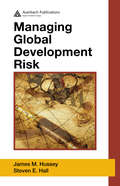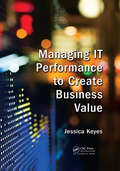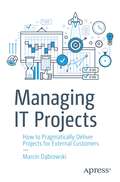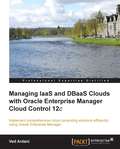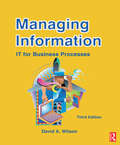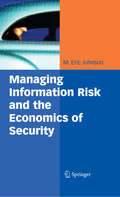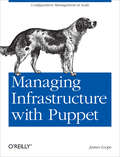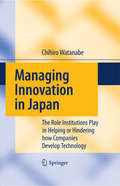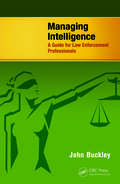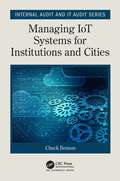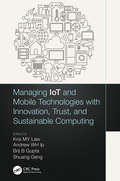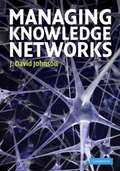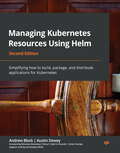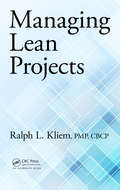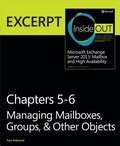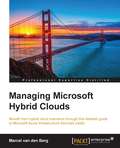- Table View
- List View
Managing Emerging Data Technologies: Concepts and Use
by Duncan R. ShawEmerging data technologies are one of several forces that are changing the world. This textbook shows how technologies such as the Internet of Things, Artificial Intelligence and data analytics are altering business operations and strategy. Following a unique, three-part structure, the book offers: • a macro view of the environmental drivers which are changing organisations • a meso view of how organisations and business functions are responding • a micro view of the skills needed to take advantage of the new opportunities that these technologies bring A wide range of examples featuring well-known companies aid understanding, while practical activities help students to develop the skills they need in business. A downloadable teaching guide and PowerPoints are available for those using the book in their teaching. Managing Emerging Data Technologies: Concepts and Use is essential reading for upper-undergraduate and postgraduate students of courses related to new digital data technologies in business, as well as anyone looking to use these technologies in their organisation. Duncan R. Shaw teaches business strategy and data technology strategy at business schools around the world, including Alliance Manchester Business School in Hong Kong, and Nottingham University Business School in the UK and Malaysia.
Managing Global Development Risk
by Steven E. Hall James M. HusseyWhile global sourcing has expanded dramatically in terms of activities, consistent challenges remain for organizations that choose such a business decision. These challenges include maximizing the opportunity afforded by globalization, fully realizing potential gains, and managing the risks inherent to global development. In addition, while companies continue to start or expand their use of global resources, little is being done to help project managers, business analysts, architects, and others succeed in this new environment. Built upon real-world experiences, Managing Global Development Risk provides the tools, techniques, and knowledge necessary to achieve project success with offshore resources. By reading and utilizing the templates within this book, you will acquire: Knowledge of project management principles and their application, Understanding of software development processes and their application , Insight into the diverse personalities within your global development team and the appropriate management and communications style to achieve success. Awareness of cultural issues and mannerisms that will enhance your ability to guide your team To fully realize the benefits of global development, a proper mix of local and offshore resources is essential. This book is an important tool that can help you gain the necessary competency and expand your skills in this critical area.
Managing High-Tech Services Using a CRM Strategy
by Donald F. BlumbergAs high-tech service industries grow more competitive, the need to develop customer focused business strategies becomes imperative. Managing High-Tech Services Using a CRM Strategy explores how to manage and direct any service organization utilizing a high tech strategy supported by the Customer Relationship Management (CRM) infrastructure, enablin
Managing Humans: Biting and Humorous Tales of a Software Engineering Manager
by Michael LoppRead hilarious stories with serious lessons that Michael Lopp extracts from his varied and sometimes bizarre experiences as a manager at Apple, Pinterest, Palantir, Netscape, Symantec, Slack, and Borland. Many of the stories first appeared in primitive form in Lopp’s perennially popular blog, Rands in Repose. The Third Edition of Managing Humans contains a whole new season of episodes from the ongoing saga of Lopp's adventures in Silicon Valley, together with classic episodes remastered for high fidelity and freshness.Whether you're an aspiring manager, a current manager, or just wondering what the heck a manager does all day, there is a story in this book that will speak to you—and help you survive and prosper amid the general craziness of dysfunctional bright people caught up in the chase of riches and power. Scattered in repose among these manic misfits are managers, an even stranger breed of people who, through a mystical organizational ritual, have been given power over the futures and the bank accounts of many others.Lopp's straight-from-the-hip style is unlike that of any other writer on management and leadership. He pulls no punches and tells stories he probably shouldn't. But they are magically instructive and yield Lopp’s trenchant insights on leadership that cut to the heart of the matter—whether it's dealing with your boss, handling a slacker, hiring top guns, or seeing a knotty project through to completion.Writing code is easy. Managing humans is not. You need a book to help you do it, and this is it.What You'll LearnLead engineersHandle conflictHire wellMotivate employeesManage your bossDiscover how to say noUnderstand different engineering personalitiesBuild effective teamsRun a meeting wellScale teamsWho This Book Is ForManagers and would-be managers staring at the role of a manager wondering why they would ever leave the safe world of bits and bytes for the messy world of managing humans. The book covers handling conflict, managing wildly differing personality types, infusing innovation into insane product schedules, and figuring out how to build a lasting and useful engineering culture.
Managing IT Performance to Create Business Value
by Jessica KeyesManaging IT Performance to Create Business Value provides examples, case histories, and current research for critical business issues such as performance measurement and management, continuous process improvement, knowledge management, risk management, benchmarking, metrics selection, and people management. It gives IT executives strategies for improving IT performance and delivering value, plus it guides them in selecting the right metrics for their IT organizations. Additionally, it offers knowledge management strategies to mature an organization, shows how to manage risks to exploit opportunities and prepare for threats, and explains how to baseline an IT organization’s performance and measure its improvement. <P><P>Consisting of 10 chapters plus appendices, the book begins with an overview of performance-based strategic planning, after which it discusses the development of a quality improvement (QI) plan, establishing benchmarks, and measuring performance improvements. It covers how to design IT-specific measures and financial metrics as well as the establishment of a software measurement program. From there, it moves on to designing people improvement systems and discusses such topics as leadership, motivation, recruitment, and employee appraisal. <P><P>The final few chapters show how to use balanced scorecards to manage and measure knowledge-based social enterprising and to identify, analyze, and avoid risks. In addition to covering new methods and metrics for measuring and improving IT processes, the author looks at strategies for measuring product development and implementing continuous innovation. The final chapter considers customer value systems and explains how to use force field analysis to listen to customers with the goal of improving customer satisfaction and operational excellence.
Managing IT Projects: How to Pragmatically Deliver Projects for External Customers
by Marcin DąbrowskiUrgent deadlines, constant lack of time, permanent delays - these are the most faithful companions and, at the same time, the greatest enemies of the project manager. Even certified project managers, people with enormous knowledge and a lot of experience, find themselves in a situation where they need great mental resilience in order not to give up. The book is a complete manual for all critical situations a project manager might need to handle along the project’s lifecycle. Written by a project manager with many years of experience, each chapter contains real-life examples with analysis and guidelines. You’ll benefit from the down-to-earth knowledge that usually project managers learn over the course of years in critical and stressful situations with no preparation beforehand. It’s not about academic methodologies – it’s about pragmatic solutions that work in real-life. Far too often, the wise theory of IT project management has nothing to do with reality. Managing IT Projects is your special compendium of knowledge, featuring "project management black magic,” chock full of proven recipes for project managers and IT organization managers, as well as advice on how to act in critical situations.What You'll LearnExamine the main reasons for delays in projects and see where they come from Review the key success factors in managing projects beyond project management methodologies and techniquesUnderstand the critical moments of projects and see how to prepare for themApply a pragmatic strategy and philosophy for successful project delivery and cooperation with customers Who This Book Is ForSoftware developers, project managers, engineering managers and software development directors, sales reps, executive and founders
Managing IT for Innovation: Dynamic Capabilities and Competitive Advantage (Routledge Studies in Innovation, Organizations and Technology)
by Mitsuru KodamaWith recent advances in IT in areas such as AI and IoT, collaboration systems such as business chat, cloud services, conferencing systems, and unified communications are rapidly becoming widely used as new IT applications in global corporations’ strategic activities. Through in-depth longitudinal studies of global corporations, the book presents a new theoretical framework and implications for IT-enabled dynamic capabilities using collaboration systems from the perspective of micro strategy theory and organization theory. The content of the book is based on longitudinal analyses that employ various qualitative research methods including ethnography, participant observation, action research and in-depth case studies of global corporations in Europe, the United States and Asia that actively use collaboration systems. It presents a new concept of micro dynamism whereby dynamic "IT-enabled knowledge communities" such as "IT-enabled communities of practice" and "IT-enabled strategic communities" create "IT-enabled dynamic capabilities" through the integration of four research streams - an information systems view, micro strategy view, micro organization view and knowledge-based view. The book demonstrates that collaboration systems create, maintain and develop "IT-enabled knowledge communities" within companies and are strategic IT applications for enhancing the competitiveness of companies in the ongoing creation of new innovation and the realization of sustainable growth in a 21st century knowledge-based society. This book is primarily written for academics, researchers and graduate students, but will also offer practical implications for business leaders and managers. Its use is anticipated not only in business and management schools, graduate schools and university education environments around the world but also in the broad business environment including management and leadership development training.
Managing IT in einer digitalen Welt: Zusammenhänge der IT verstehen und die Kriterien für eine erfolgreiche Transformation beherrschen
by Lionel PilorgetDie IT ist für viele Unternehmen unersetzbar geworden. Die Digitalisierung, die in der Zwischenzeit sich verbreitet hat und die Gesellschaft immer weiter prägt, bleibt eine Priorität für viele Unternehmen. Nun hat die Komplexität zugenommen. Es sei die Wahl eines nachhaltigen Partners für eine Cloud Transformation, die Garantie, dass neue digitale Lösungen absolut sicher sind, oder das Angebot eines modernen Arbeitsplatzes, wo Home Office selbstverständlich ist. Entscheidend und gleichzeitig herausfordernd ist die Tatsache, dass alle Ebenen einer IT Organisation gut zusammenarbeiten müssen, damit das Unternehmen sich erfolgreich weiterentwickeln kann. Es handelt sich um die strategische Ebene mit den entsprechenden strategischen Entscheidungen, in erster Linie "make-or-buy" Entscheide. Weiterhin muss die taktische Ebene mit der Durchführung von Projekten und Releases und gleichzeitig das Angebot von hochwertigen IT Services sehr gut funktionieren. Die operative Ebene stellt das Fundament dar, wo die Abwicklung aller Tätigkeiten des Unternehmens sichergestellt werden muss. Verfügbarkeit und Performanz sind Key. Das ganze "Haus der IT" muss in dem Kontext des Unternehmens funktionieren. Die Kultur der Organisation und die Strukturen müssen natürlich berücksichtigt werden. Um eine optimale Transformation der IT ermöglichen zu können, ist es wichtig, ein gutes Verständnis einer IT Organisation zu besitzen und die Zusammenhänge zu verstehen.
Managing IaaS and DBaaS Clouds with Oracle Enterprise Manager Cloud Control 12c
by Ved AntaniThis book is a step-by-step tutorial filled with practical examples which will show readers how to configure and manage IaaS and DBaaS with Oracle Enterprise Manager.If you are a cloud administrator or a user of self-service provisioning systems offered by Enterprise Manager, this book is ideal for you. It will also help administrators who want to understand the chargeback mechanism offered by Enterprise Manager.An understanding of the basic building blocks of cloud computing such as networking, virtualization, storage, and so on, is needed by those of you interested in this book
Managing Information
by David A Wilson'Managing Information' describes how successful organizations make best use of information and knowledge - the key resources in business. It explains why information technology is essential for the management of business processes, and should be central to any business strategy. This updated edition provides a compelling rationale for organizations to use appropriate systems, and for individuals to acquire the skills to manage and use the systems. It describes how computer systems continue to evolve to meet business needs, and provides examples and exercises to help readers develop their skills. There is a new emphasis on the Internet - how to use it to keep up to date with the latest business issues, and how teams can communicate and collaborate with intranets.All of the most common sub-systems are described and explained, including Enterprise Resource Planning (ERP), Business-to-Business (B2B), Business-to-Consumer (B2C), Supply Chain Management (SCM), Customer Relationship Management (CRM) and Enterprise Application Integration (EAI). The latest developments are described, including services available through the Internet from Application Service Providers (ASP), collaborative commerce and Business Process Management (BPM).There are introductory and more advanced computer exercises to consolidate learning and demonstrate how to acquire, store, organize and present information, using Word, Excel, PowerPoint and Explorer.
Managing Information Risk and the Economics of Security
by M. Eric JohnsonThe lifeblood of the global economy, information has become a source of growing risk as more firms maintain information online. With risks now fueled by sophisticated, organized, malicious groups, information security requires not only technology, but a clear understanding of potential risks, decision-making behaviors, and metrics for evaluating business and policy options. Managing Information Risk and the Economics of Security, an edited volume contributed by well-established researchers in the field worldwide, presents the latest research on economics driving both the risks and the solutions. Covering the implications of policy within firms and across countries, this volume provides managers and policy makers with new thinking on how to manage risk. Managing Information Risk and the Economics of Security is designed for managers, policy makers, and researchers focusing on economics of information security, as well as for advanced-level students in computer science, business management and economics.
Managing Information Risk: A Director's Guide
by Stewart MitchellThis pocket guide addresses the scope of risks involved in a modern IT system, and outlines strategies for working through the process of putting risk management at the heart of your corporate culture. This pocket guide should provide decision makers with a solid overview of the factors they need to consider and a framework for implementing a regime that suits their needs. It provides a checklist of steps that companies need to take to safeguard against various threats, highlights potential vulnerabilities and lists methodologies for mitigating against the risks. This pocket guide draws on previous works by senior security advisory bodies - in particular the US National Institute of Standards and Technology, which has produced numerous landmark 'Special Publications' on the subject, and various UK government guidelines drawn up in the wake of high- profile data breaches. UK governmental and industry white papers were also consulted during research, including interviews with security analysts and board-level risk management practitioners.
Managing Information Technology
by Francisco Castillo Korina MonosoThere are two different, interdependent components of IT that are important to a CIO: strategy, which is long-term; and tactical and operational concerns, which are short-term. Based on this distinction and its repercussions, this book clearly separates strategy from day-to-day operations and projects from operations – the two most important functions of a CIO.It starts by discussing the ideal organization of an IT department and the rationale behind it, and then goes on to debate the most pressing need – managing operations. It also explains some best industry standards and their practical implementation, and discusses project management, again highlighting the differences between the methodologies used in projects and those used in operations. A special chapter is devoted to the cutover of projects into operations, a critical aspect seldom discussed in detail. Other chapters touch on the management of IT portfolios, project governance, as well as agile project methodology,how it differs from the waterfall methodology, and when it is convenient to apply each. In this second edition, besides a number of corrections and updates throughout the text, chapter 8 on “Agile Project Management” replaces the former chapter 8 completely, and chapter 10 on “IT Security” has been newly introduced as this topic has become more and more important for both management and operations during the last six years.Taking the fundamental principles of IT service management and best practices in project management, the book offers a single, seamless reference for IT managers and professionals. It is highly practical, explaining how to apply these principles based on the author’s extensive experience in industry.
Managing Infrastructure with Puppet: Configuration Management at Scale
by James LoopeGet started with Puppet, and learn how this popular configuration management framework helps you automate your servers. This concise introduction shows you how to use Puppet’s tools and templates to organize and execute configuration plans on Linux, Unix, and Windows servers. Through code samples and real-world examples, you’ll learn how to manage pools of servers and virtual instances, and how to administer access control. If you’re new to Puppet, but familiar with systems administration and Ruby language basics, this book is the ideal way to start using this open source framework.Learn Puppet fundamentals, including its manifest syntax and built-in functionsStore configurations in a central location with PuppetMaster, and define which configurations apply to which nodesBuild a framework to create user accounts in place of LDAP or Kerberos KDCApply techniques to execute and manage server configurations with MCollectiveUse Puppet as an auditing tool to ensure that configurations are correctGather information on the nodes you manage with the Facter library
Managing Innovation in Japan
by Chihiro WatanabeWhy do some country's hi-tech firms innovate better than others? Why did hi-tech firms from the United States outperform such Japanese companies in the 1990s? Through a wealth of empirical evidence, the book compares the development trajectory of manufacturing technology and information technology both between Japanese companies and between companies based in the US, Europe, Australia, India and China. This book shows that institutional systems such as culture, tradition, consumers and local business practices play key roles in how companies develop technology. These factors also influence the very characteristics of the products that the hi-tech firms produce. With a number of case studies the author demonstrates how the most successful and innovative companies recognize these roles and incorporate them into their practices.
Managing Intelligence: A Guide for Law Enforcement Professionals
by John BuckleyManaging Intelligence: A Guide for Law Enforcement Professionals is designed to assist practitioners and agencies build an efficient system to gather and manage intelligence effectively and lawfully in line with the principles of intelligence-led policing. Research for this book draws from discussions with hundreds of officers in different agencies, roles, and ranks from the UK, United States, Australia, New Zealand, and Canada. Highlighting common misunderstandings in law enforcement about intelligence, the book discusses the origins of these misunderstandings and puts intelligence in context with other policing models.
Managing IoT Systems for Institutions and Cities (Internal Audit and IT Audit)
by Chuck BensonThis book defines what IoT Systems manageability looks like and what the associated resources and costs are of that manageability. It identifies IoT Systems performance expectations and addresses the difficult challenges of determining actual costs of IoT Systems implementation, operation, and management across multiple institutional organizations. It details the unique challenges that cities and institutions have in implementing and operating IoT Systems.
Managing IoT and Mobile Technologies with Innovation, Trust, and Sustainable Computing
by Edited by Kris MY Law, Andrew WH Ip, Brij B Gupta and Shuang GengFocused on the latest mobile technologies, this book addresses specific features (such as IoT) and their adoptions that aim to enable excellence in business in Industry 4.0. Furthermore, this book explores how the adoption of these technologies is related to rising concerns about privacy and trusted communication issues that concern management and leaders of business organizations. Managing IoT and Mobile Technologies with Innovation, Trust, and Sustainable Computing not only targets IT experts and drills down on the technical issues but also provides readers from various groups with a well-linked concept about how the latest trends of mobile technologies are closely related to daily living and the workplace at managerial and even individual levels.
Managing Knowledge Networks
by J. David JohnsonThe information context of the modern organization is rapidly evolving in the face of intense global competition. Information technologies, including databases, new telecommunications systems, and software for synthesizing information, make a vast array of information available to an ever expanding number of organizational members. Management's exclusive control over knowledge is steadily declining, in part because of the downsizing of organizations and the decline of the number of layers in an organizational hierarchy. These trends, as well as issues surrounding the Web 2.0 and social networking, mean that it is increasingly important that we understand how informal knowledge networks impact the generation, capturing, storing, dissemination, and application of knowledge. This innovative book provides a thorough analysis of knowledge networks, focusing on how relationships contribute to the creation of knowledge, its distribution within organizations, how it is diffused and transferred, and how people find it and share it collaboratively.
Managing Kubernetes Resources Using Helm: Simplifying how to build, package, and distribute applications for Kubernetes, 2nd Edition
by Andrew Block Austin Dewey Rimantas Mocevicius “rimusz”Reduce the complexity of managing applications on Kubernetes and develop an enterprise pattern for application deliveryKey FeaturesLearn best practices from the core maintainer of Helm for application delivery and life cycle managementManage applications deployed in Kubernetes effectively using HelmGo beyond the basics when using Helm with key security considerations and management optionsBook DescriptionContainerization is one of the best ways to implement DevOps, and learning how to execute it effectively is an essential part of a developer's skillset. Kubernetes is the current industry standard for container orchestration. This book will help you discover the efficiency of managing applications running on Kubernetes with Helm. Starting with a brief introduction to Helm and its impact on users working with containers and Kubernetes, you'll delve into the primitives of Helm charts and their architecture and use cases. From there, you'll understand how to write Helm charts in order to automate application deployment on Kubernetes and work your way toward more advanced strategies. These enterprise-ready patterns are focused on concepts beyond the basics so that you can use Helm optimally, looking at topics related to automation, application development, delivery, lifecycle management, and security. By the end of this book, you'll have learned how to leverage Helm to build, deploy, and manage applications on Kubernetes.What you will learnUnderstand how to deploy applications on Kubernetes with easePackage dynamic applications for deployment on KubernetesIntegrate Helm into an existing software release processDevelop an enterprise automation strategy on Kubernetes using HelmUse Helm within a Helm Kubernetes operatorLeverage Helm in a secure and stable manner that fits the enterpriseDiscover the ins and outs of automation with HelmWho this book is forThis book is for Kubernetes developers or administrators who are interested in learning Helm to provide automation for app development on Kubernetes. Although no prior knowledge of Helm is required, basic knowledge of Kubernetes application development will be useful.
Managing Kubernetes: Operating Kubernetes Clusters in the Real World
by Brendan Burns Craig TraceyWhile Kubernetes has greatly simplified the task of deploying containerized applications, managing this orchestration framework on a daily basis can still be a complex undertaking. With this practical book, site reliability and DevOps engineers will learn how to build, operate, manage, and upgrade a Kubernetes cluster—whether it resides on cloud infrastructure or on-premises.Brendan Burns, cofounder of Kubernetes, and Craig Tracey, staff field engineer at Heptio, dissect how Kubernetes works internally and demonstrate ways to maintain, adjust, and improve the cluster to suit your particular use case. You’ll learn how to make architectural choices for designing a cluster, managing access control, monitoring and alerting, and upgrading Kubernetes. Dive in and discover how to take full advantage of this orchestration framework’s capabilities.Learn how your cluster operates, how developers use it to deploy applications, and how Kubernetes can facilitate a developer’s jobAdjust, secure, and tune your cluster by understanding Kubernetes APIs and configuration optionsDetect cluster-level problems early and learn the steps necessary to respond and recover quicklyDetermine how and when to add libraries, tools, and platforms that build on, extend, or otherwise improve a Kubernetes cluster
Managing Lean Projects
by Ralph L. KliemLean is a set of disciplines that can result in tremendous savings and profitability for companies. It can significantly reduce cycle times and increase customer satisfaction. Lean, however, must be applied efficiently and effectively to achieve optimum results. This book discusses project management concepts, tools, and techniques as they apply to
Managing Machine Learning Projects: From design to deployment
by Simon ThompsonGuide machine learning projects from design to production with the techniques in this unique project management guide. No ML skills required!In Managing Machine Learning Projects you&’ll learn essential machine learning project management techniques, including: Understanding an ML project&’s requirements Setting up the infrastructure for the project and resourcing a team Working with clients and other stakeholders Dealing with data resources and bringing them into the project for use Handling the lifecycle of models in the project Managing the application of ML algorithms Evaluating the performance of algorithms and models Making decisions about which models to adopt for delivery Taking models through development and testing Integrating models with production systems to create effective applications Steps and behaviors for managing the ethical implications of ML technology Managing Machine Learning Projects is an end-to-end guide for delivering machine learning applications on time and under budget. It lays out tools, approaches, and processes designed to handle the unique challenges of machine learning project management. You&’ll follow an in-depth case study through a series of sprints and see how to put each technique into practice. The book&’s strong consideration to data privacy, and community impact ensure your projects are ethical, compliant with global legislation, and avoid being exposed to failure from bias and other issues. About the Technology Ferrying machine learning projects to production often feels like navigating uncharted waters. From accounting for large data resources to tracking and evaluating multiple models, machine learning technology has radically different requirements than traditional software. Never fear! This book lays out the unique practices you&’ll need to ensure your projects succeed. About the Book Managing Machine Learning Projects is an amazing source of battle-tested techniques for effective delivery of real-life machine learning solutions. The book is laid out across a series of sprints that take you from a project proposal all the way to deployment into production. You&’ll learn how to plan essential infrastructure, coordinate experimentation, protect sensitive data, and reliably measure model performance. Many ML projects fail to create real value—read this book to make sure your project is a success. What's Inside Set up infrastructure and resource a team Bring data resources into a project Accurately estimate time and effort Evaluate which models to adopt for delivery Integrate models into effective applications About the Reader For anyone interested in better management of machine learning projects. No technical skills required. About the Author Simon Thompson has spent 25 years developing AI systems to create applications for use in telecoms, customer service, manufacturing and capital markets. He led the AI research program at BT Labs in the UK, and is now the Head of Data Science at GFT Technologies. Table of Contents 1 Introduction: Delivering machine learning projects is hard; let&’s do it better 2 Pre-project: From opportunity to requirements 3 Pre-project: From requirements to proposal 4 Getting started 5 Diving into the problem 6 EDA, ethics, and baseline evaluations 7 Making useful models with ML 8 Testing and selection 9 Sprint 3: system building and production 10 Post project (sprint O)
Managing Mailboxes, Groups, & Other Objects: EXCERPT from Microsoft Exchange Server 2013 Inside Out
by Tony RedmondThis content is a direct excerpt of Chapters 5 and 6 from the book Microsoft Exchange Server 2013 Inside Out: Mailbox & High Availability. This concise ebook is offered independently of the larger book for those seeking specific, focused information on managing mailboxes, groups, and other objects in Exchange Server 2013. Directly excerpts Chapters 5 and 6 from the book Microsoft Exchange Server 2013 Inside Out: Mailbox & High Availability Offered as concise, standalone content for Exchange professionals looking for narrowly focused reference or specific problem-solving information on managing mailboxes, groups, and other objects Written by award-winning author Tony Redmond, MVP for Exchange Server
Managing Microsoft Hybrid Clouds
by Marcel Van BergIf you're an IT professional, manager, consultant, or architect who wants to learn about hybrid cloud computing using Azure, then this is the book for you.

